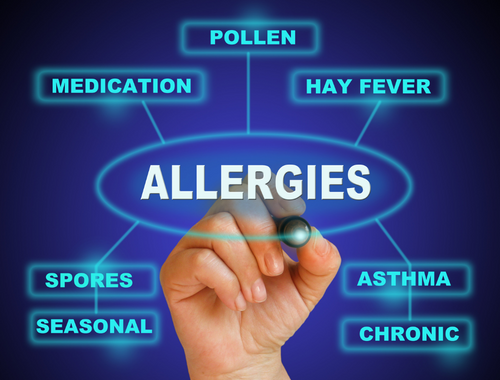Difference Between Inflammation and Allergy
Both inflammation and allergy may involve swelling, itchiness, and rashes. Specifically, inflammation is the process by which the body’s white blood cells and the substances they produce guard us against infection from external invaders (i.e., bacteria and viruses). On the other hand, an allergy occurs when the body reacts to something that is typically harmless. The subsequent discussions further look into their distinctions.

What is Inflammation?
Inflammation came from the Latin word “inflammare” which literally means “to set on fire with passion”. While the translation may sound romantic, the symptoms of inflammation which include swelling, pain, loss of function, heat, and redness do not paint a passionate vibe. Still, inflammation may be beneficial as it is crucial in the healing process; it is a typical component of the body’s defense against damage or infection. It is the process by which the body’s white blood cells and the substances they produce guard us against infection from external invaders (i.e., bacteria and viruses). However, when it affects healthy tissues or persists for an extended period of time, inflammation can be harmful (National Institute of Environmental Health Sciences, 2021).
The two main types of inflammation are acute and chronic. Acute inflammation is caused by tissue injury or harmful pathogens. The onset is rapid and it lasts for a few days; when it does not improve, an abscess develops, or it becomes chronic. As for chronic inflammation, it is caused by pathogens that cannot be broken down or an overactive immune system. The onset is usually slow, and it can last for months to years. It can lead to the scarring, thickening, or death of tissues (Felman, 2020).

What is Allergy?
Allergy came from the German word “allergie” which is a combination of the Greek words “allos” which means “other”, “different”, or “strange”, and “ergon” which means “activity”. It occurs when the body reacts to something (allergen) that is typically harmless (i.e., dust, fur, pollen, certain foods, insect stings, certain medicines, etc.). The symptoms include sneezing, runny nose, breathlessness, rashes, itchy skin, pain or tenderness (on the forehead, eyes, or cheeks), loose bowel movement, vomiting, diarrhea, and swollen lips, eyes, mouth, or throat (National Health Service, 2022).
The following are the usual types of allergies (Asthma and Allergy Foundation of America, 2015):
- Drug Allergy
Only a small percentage have true drug (medication) allergies. The majority of drug reactions aren’t allergic; rather, they’re adverse effects from the medication’s qualities. The patient’s history and symptoms are typically the only factors used to make a diagnosis of the medication reaction’s root cause. Drug allergy skin testing is occasionally carried out as well.
- Food Allergy
According to the Food Allergen Labeling and Consumer Protection Act of 2004 (FALCPA), the eight major food allergens include milk, eggs, fish, shellfish, tree nuts, peanuts, wheat, and soybeans. According to the Food Allergy Safety, Treatment, Education, and Research (FASTER) Act, sesame is the 9th major food allergen. It was signed into law on April 23, 2021 and will take effect on January 1, 2023 (United States Food and Drug Administration, 2022).
- Insect Allergy
Among stinging insects, bees, wasps, hornets, yellow jackets, and fire ants are the most often associated allergens. Insects without stingers can also trigger allergic responses. Cockroaches and dust mites which resemble insects are the most prevalent.
- Latex Allergy
Gloves, balloons, condoms, erasers, dental products, and other items made of natural rubber include latex. A latex allergy poses a significant risk to one’s health. The most common immune system reaction to latex is allergic contact dermatitis.
- Mold Allergy
Fungi include mold and mildew. Allergies can occur all year long since fungi can flourish in so many environments, both indoor and outdoor spaces.
- Pet Allergy
Pet allergies are a typical occurrence. They are due to allergic reactions to proteins found in the skin, urine, or saliva of animals. It is crucial to understand that there is no breed of dog or cat that is hypoallergenic.
- Pollen Allergy
One of the most frequent causes of seasonal allergies is pollen. Although many people refer to pollen allergy as “hay fever,” medical professionals call it “seasonal allergic rhinitis.”
Difference between Inflammation and Allergy
Definition
Inflammation is a typical component of the body’s defense against damage or infection. It is the process by which the body’s white blood cells and the substances they produce guard us against infection from external invaders (i.e., bacteria and viruses). However, when it affects healthy tissues or persists for an extended period of time, inflammation can be harmful (National Institute of Environmental Health Sciences, 2021). In comparison, allergies occur when the body reacts to something that is typically harmless (National Health Service, 2022).
Etymology
Inflammation came from the Latin word “inflammare” which literally means “to set on fire with passion”. As for allergy, it came from the German word “allergie” which is a combination of the Greek words “allos” which means “other”, “different”, or “strange”, and “ergon” which means “activity”.
Symptoms
The symptoms of inflammation typically include swelling, pain, loss of function, heat, and redness (National Institute of Environmental Health Sciences, 2021) while those of allergy include sneezing, runny nose, breathlessness, rashes, itchy skin, pain or tenderness (on the forehead, eyes, or cheeks), loose bowel movement, vomiting, diarrhea, and swollen lips, eyes, mouth, or throat (National Health Service, 2022).
Types
The two main types of inflammation are acute and chronic (Felman, 2020). In comparison, the usual types of allergies are drug allergy, food allergy, insect allergy, latex allergy, mold allergy, pet allergy, and pollen allergy (Asthma and Allergy Foundation of America, 2015).
Inflammation vs Allergy

Frequently Asked Questions:
Can allergies cause inflammation in your body?
Yes, certain allergic reactions can cause inflammation which can lead to body aches.
What is the relationship between inflammation and allergy?
Inflammation can be caused by allergic reactions.
How do I reduce inflammation from allergies?
Antihistamines can control symptoms of allergic reactions including inflammation. Severe reactions may need an EpiPen (epinephrine auto-injector) which helps to prevent further release of inflammatory chemicals (Ogbru, 2022).
Is allergy and inflammation same?
No, allergies occur when the body reacts to something that is typically harmless while inflammation is the process by which the body’s white blood cells and the substances they produce guard us against infection from external invaders (i.e., bacteria and viruses).
How can I reduce inflammation in my whole body?
Inflammation may be reduced by having at least 7 hours of sleep, having enough exercise, consuming probiotics and anti-inflammatory foods, fasting intermittently, temporarily cutting out dairy and gluten, and managing stress.
How do you know if you have inflammation in your body?
The symptoms of inflammation include swelling, pain, loss of function, heat, and redness.
Summary
- Inflammation is the process by which the body’s white blood cells and the substances they produce guard us against infection from external invaders (i.e., bacteria and viruses).
- It occurs when the body reacts to something (allergen) that is typically harmless (i.e., dust, fur, pollen, certain foods, insect stings, certain medicines, etc.).
- The symptoms of inflammation typically include swelling, pain, loss of function, heat, and redness while those of allergy include sneezing, runny nose, breathlessness, rashes, itchy skin, pain or tenderness, loose bowel movement, vomiting, diarrhea, and swelling.
- Difference Between Hematoma and Melanoma - February 9, 2023
- Difference Between Bruising and Necrosis - February 8, 2023
- Difference Between Brain Hematoma and Brain Hemorrhage - February 8, 2023
Search DifferenceBetween.net :
Leave a Response
References :
[0]Felman, A. (2020). Everything you need to know about inflammation. Medical News Today. https://www.medicalnewstoday.com/articles/248423
[1]National Health Service (2022). Allergies. https://www.nhs.uk/conditions/allergies/#:~:text=An%20allergy%20is%20where%20your,they%20can%20be%20very%20serious.
[2]National Institute of Environmental Health Sciences (2021). Inflammation. https://www.niehs.nih.gov/health/topics/conditions/inflammation/index.cfm#:~:text=Inflammation%20is%20a%20normal%20part,persist%20for%20months%20or%20years.
[3]Ogbru, O. (2022). EpiPen for anaphylaxis. Medicine Net. https://www.medicinenet.com/epinephrine_auto-injector/article.htm#what_is_epipen_and_how_does_it_work_mechanism_of_action
[4]United States Food and Drug Administration (2022). Food allergies. https://www.fda.gov/food/food-labeling-nutrition/food-allergies#:~:text=This%20law%20identified%20eight%20foods,identified%20as%20major%20food%20allergens.
